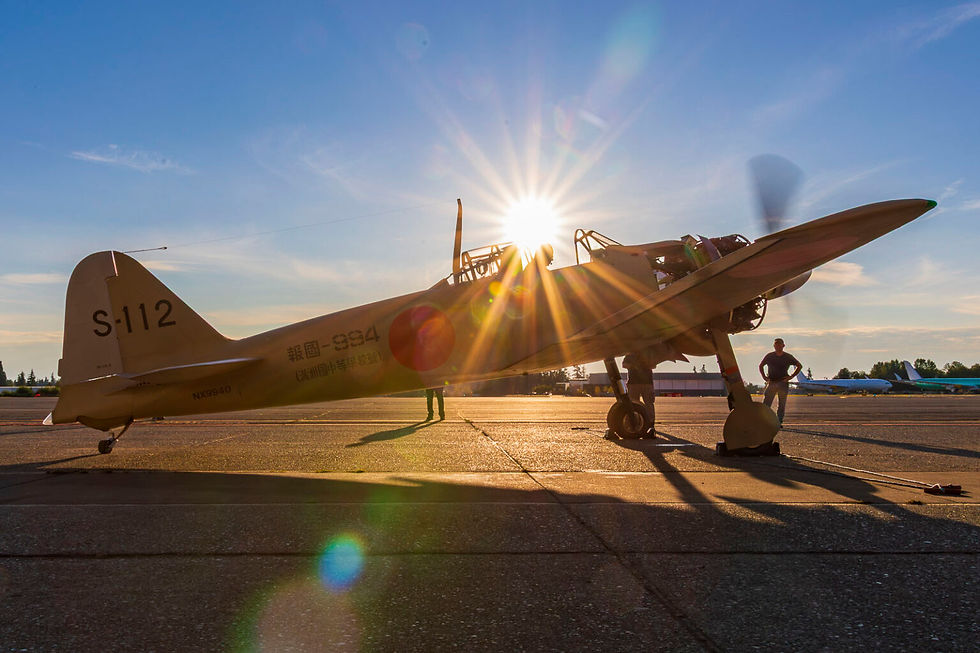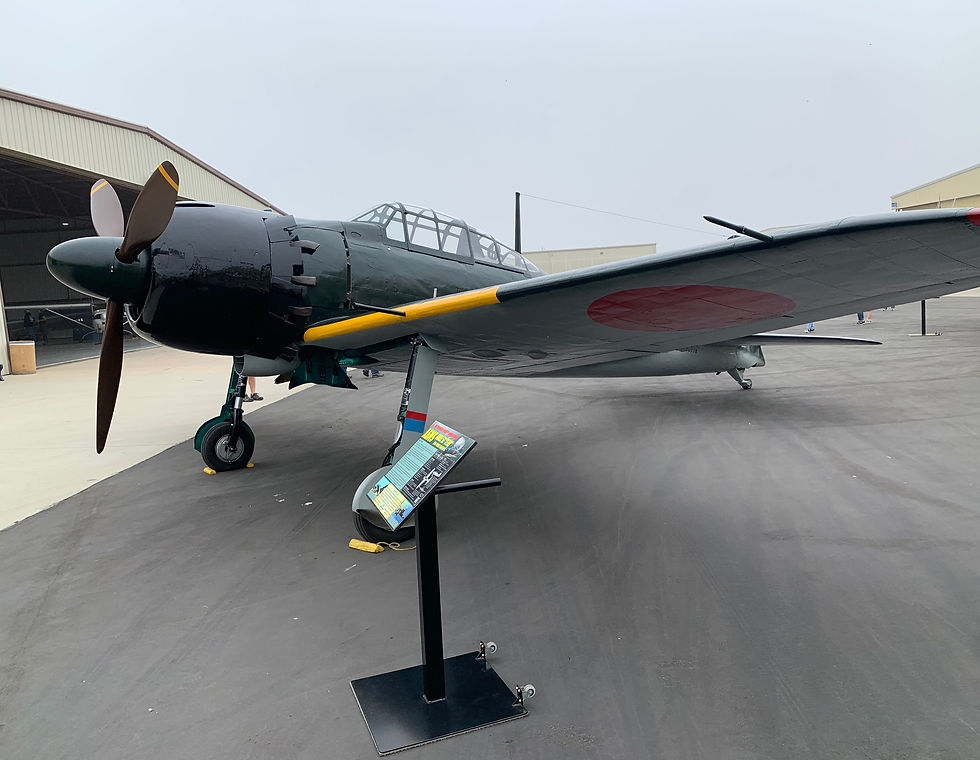A Zero Returns to the Sky: A Decades-Long Journey from Pacific Wreck to Flying Legend
- EA Baker

- Aug 21, 2025
- 8 min read
Updated: Sep 3, 2025
On 5 May in the Pacific Northwest, the first post-restoration flight of the Military Aviation Museum's Mitsubishi A6M3 Zero lifted off into the sky. The whine of the electric starter motor pierced the air at Paine Field in Everett, Washington, followed by the steady rumble of an R-1830 engine that hadn't been heard from this Zero in nearly eight decades. Chief pilot Mike Spalding was at the controls as the former Imperial Japanese Navy fighter, most likely the first Model 32 variant to fly since 1945, gently rose from the runway.
A small contingent of Museum personnel and the restoration team at Legend Flyers cheered from the ground as the distinctive silhouette banked westward over Possession Sound. For those watching, it was impossible to fully comprehend the winding journey of survival this aircraft represents. The gulf of time between today's flight and early 1990, when the Sterling brothers recovered the two corroded hulks from Taroa Island that would form the basis of this Zero, spans almost as many years as passed between the aircraft's original manufacture in 1942 and its eventual salvage.
Resurrection from the Pacific
The story begins not in a factory or hangar, but on a remote coral atoll in the Marshall Islands. Two Mitsubishi A6M3 Model 32 Zeros, serial numbers 3148 and 3145, had met their end in the savage fighting of World War II's Pacific theater. For nearly five decades, they lay forgotten among the palm trees and coral sand of Taroa Island, slowly surrendering to the tropical climate that claims so many wartime relics.

In 1990, the Sterling brothers made the journey to this distant outpost and began the arduous process of recovery. What they found were two aircraft that had been reduced to little more than aluminum skeletons, their fabric control surfaces long since rotted away, their engines seized by decades of salt air and neglect. Yet within these corroded remains lay the essential components needed to create one complete aircraft, the forward fuselage and wings of s/n 3148, and the rear fuselage of s/n 3145.
Legend Flyers would eventually acquire the project in 2011, inheriting not just the recovered components but also the dreams and frustrations of several different restoration shops that had attempted to bring this Zero back to life. When the Military Aviation Museum became involved in late 2020, the airframe appeared close to completion, yet more work was still required to make it airworthy.
The Challenge of Authenticity
Restoring a Zero presents unique challenges that go far beyond typical warbird projects. Unlike American aircraft, for which parts and documentation remain relatively abundant, Japanese warbirds exist in a world of scarcity. Original components are virtually unobtainable, forcing restorers to become detective, archaeologist, and craftsman all at once.
The decision to power the Zero with a Pratt & Whitney R-1830 engine rather than the original Sakae 12 radial reflects both practical necessity and historical precedent. The Sakae engines that powered Japan's most famous fighter have long since disappeared from the warbird world, making the American powerplant the only viable option for returning the aircraft to flight status. Chief pilot Mike Spalding's extensive experience with R-1830 engines provided additional confidence as the restoration neared completion.
Weather, Waiting, and First Flight
By late 2024, the Zero had reached a milestone that seemed impossible just years earlier; she was genuinely ready to fly. The engine runs had been completed, the systems checked and double-checked, and all the requisite paperwork signed off. But the notorious Pacific Northwest weather had other plans. Seventy days of rain, broken only by periods of low overcast, transformed what should have been a celebration into an exercise in patience.

Throughout the winter months, the restoration team conducted final inspections and minor adjustments while waiting for suitable flying conditions. The break finally came on Monday morning, 5 May 2025. Clear skies and light winds created the perfect conditions for a first flight. At 8:00 AM, Legend Flyers formally turned over the aircraft to Mike Spalding for its inaugural post-restoration flight. Despite his extensive experience with vintage military aircraft, including the recent test flight of the Museum's Messerschmitt Me 262 replica, Spalding had never before flown an A6M. The Zero's reputation as a nimble, responsive fighter would soon be put to the test under entirely different circumstances than its designers had ever imagined.
The pre-flight ritual unfolded with practiced precision. Spalding strapped into the cockpit that had once housed Imperial Japanese Navy pilots, ran through his checklist, and signaled for the ground crew to pull the chocks. The distinctive sound of the Zero's engine, different from the original Sakae but unmistakably powerful, echoed off the hangar walls as he taxied toward runway 34L.
Mark Darrow followed in his T-34C chase plane, ready to provide safety oversight and observe any external issues that Spalding might not detect from the cockpit. The pairing of a modern trainer shadowing a restored World War II fighter captured the bridging of eras that defines contemporary warbird operations.
Paine Field's massive runway provided plenty of space for the Zero to demonstrate its flying qualities. As Spalding advanced the throttle, the fighter accelerated down the centerline with the eager responsiveness that had made her legendary. The moment of liftoff came gently, almost anticlimactically, as the Zero rose into Washington state skies.
Testing and the Road Ahead
The flight plan called for a conservative test program that included a dozen orbits over Possession Sound to check basic systems and handling characteristics before returning to base. From the ground, observers could hear the faint clatter of the engine as Spalding put the Zero through her paces, cycling landing gear and flaps while evaluating her flight characteristics.
For those watching from the Legend Flyers' hangar, the sight of the Zero airborne represented vindication of years of effort and expertise. The distinctive elliptical wing planform that had struck fear into Allied pilots now traced graceful patterns against a peaceful, American sky, no longer an instrument of war but a flying memorial to the aviators of both sides who had fought and died in aircraft like this one.
The landing approach revealed the Zero's legendary docility at low speeds. Spalding guided the fighter onto the runway with minimal drama, the touchdown so gentle it seemed almost routine. Yet for everyone involved, this moment represented the successful completion of one of the most challenging warbird restoration projects attempted in recent decades.
Despite the euphoria surrounding the first flight, significant work remains before the Zero will be ready for public display flights at the Museum's Virginia Beach home. Additional test flights will explore her full performance envelope, while systems that performed adequately for a brief test flight will need validation for the demands of regular airshow operations.
The logistics of ferrying a newly restored warbird across the continent present their own challenges. Weather routing, fuel stops, and maintenance support must all be carefully coordinated to ensure the Zero's safe arrival at her permanent base. Given the aircraft's unique status as potentially the world's only flying A6M3 Model 32, every aspect of her operation will be approached with appropriate caution.
My Experience Seeing A Japanese Zero
While this Zero does not have the original engine, I had the privilege of seeing a Zero fly with its Nakajima Sakae 31, 14-cylinder 1,130-hp air-cooled radial engine. Featured at Chino’s Planes of Fame in California, an A6M5 Type 0 Model 52 Reisen with Serial Number 5357 and Tail Number: 61-120 took to the skies during a Hangar Talk event for the anniversary of the Attack on Pearl Harbor.
Zero No. 61-120 was completed in May 1943 at the Nakajima Aircraft Company’s Oizumi plant in Gunma, Japan. It was the 2,357th aircraft of its type to roll off Nakajima’s production line. By July 1943, the fighter had entered service with the Imperial Japanese Navy’s 261st Kokutai (Air Group), where it likely flew defensive patrols over Nagasaki from its base on Kyushu.
In October 1943, the aircraft was reassigned to Iwo Jima to bolster Japan’s forward island defenses. Just a few months later, in March 1944, it was transferred again, this time to Asilito Airfield on Saipan in the Mariana Islands.

On June 18, 1944, U.S. Marines captured Asilito Airfield during the Battle of Saipan. Among the intact aircraft seized was Zero No. 61-120. Along with about a dozen other Zeros, it was shipped to the United States for evaluation. Four were restored to flying condition; two were given to the U.S. Army Air Forces, and two, including No. 61-120, were retained by the Navy.

It was then ferried to NAS Patuxent River, Maryland, on August 23, 1944, where it became one of the most tested Japanese aircraft of the war. Roughly 25 different pilots flew it, including Navy, Marine Corps, Royal Navy, and civilian test pilots. Among them was famed aviator Charles A. Lindbergh, who logged flights in the aircraft, as documented in its surviving logbook.
On January 11, 1945, the Zero was transferred back to San Diego, where frontline combat pilots were also given the rare opportunity to fly an intact enemy fighter. By the end of the war, No. 61-120 had accumulated more than 190 hours of flight testing in American hands before being declared surplus.
In 1950, the aircraft was acquired by the Museum, where it was preserved and later restored to airworthy condition in 1978. A second restoration followed in 2016. Remarkably, it still flies today with its original Nakajima Sakae radial engine, making it the only authentic, airworthy A6M Zero in the world.
Here’s a photo I took of the plane on the ground:

And here’s a short clip of the Zero flying over me at the airfield. You can’t see the plane that we,ll but it’s more about the sound of that Nakajima engine:
There are a lot of great books out there on the Japanese Zero (Saburō Sakai, the famed Japanese Zero fighter ace, wrote a book about his experiences flying the plane). Many are hard to find or out of print and aren't cheap, but this one piqued my interest, and I thought I would share it here.
Eagles of Mitsubishi: The Story of the Zero Fighter by Jiro Horikoshi

In the late 1930s, as war clouds gathered over the Pacific, a brilliant young engineer named Jiro Horikoshi faced an impossible challenge: design a fighter plane that could outfly, outmaneuver, and outrange anything in the sky. What emerged from his drafting table would become the most feared aircraft of the early Pacific War—the Mitsubishi A6M Zero.
Now, for the first time, the Zero's creator himself reveals the dramatic story behind its development. From the technical breakthroughs that made long-range fighter combat possible to the crushing weight of seeing his peaceful creation transformed into an instrument of war, Horikoshi's account is both a fascinating glimpse into aviation engineering and a deeply personal meditation on the responsibilities of innovation.
Eagles of Mitsubishi takes readers inside the hangars and wind tunnels of wartime Japan, where dedicated engineers pushed the boundaries of what was possible with aluminum, steel, and sheer determination. This is the definitive account of how one man's pursuit of aeronautical perfection helped shape the course of World War II—and changed aviation forever.
Sources and Images:







Comments